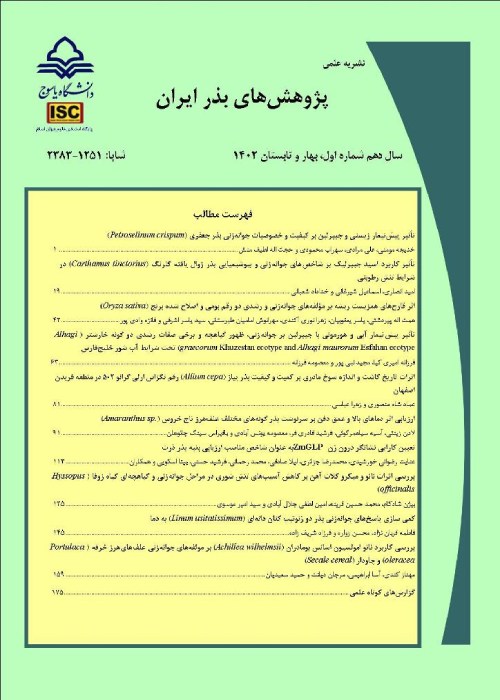Evaluation of Germination and Biochemical Changes of Two Wheat (Triticum aestivum) Cultivars Under Pb(NO3)2 Stress
Author(s):
Article Type:
Research/Original Article (دارای رتبه معتبر)
Abstract:
Introduction
Heavy metal pollution is one of the most serious environmental problems. These metals which accumulate in food chain bring about a lot of hazards to both humans and animals. Among heavy metals, lead is considered to be the most dangerous heavy metal in the environment. It contaminates the environment through the lead-acid battery industry, paint and gasoline additives, insecticides, chemical fertilizers, car exhaust pipes and soldering. The objective of this study was to investigate the effect of Pb(NO3)2 on germination characteristics and biochemical changes of two wheat cultivars (Chamran and Kohdasht cultivars).
Materials and Methods
The objective of this research was to evaluate germination and biochemical changes of two wheat cultivars under Pb(NO3)2 stress, using three-parameter sigmoid model. The experimental design adopted was factorial with a completely randomized design, as the base design, with 3 replications. The first factor was 2 wheat cultivars (Kohdasht and Chamran), and the second factor was 6 levels of Pb(NO3)2 (0, 0.25, 0.5, 0.75, 1 and 1.5 mg.L).
Results
The results showed that with increases in levels of Pb(NO3)2 stress, germination percentage, germination rate, normal seedling percentage, seedling length, seedling weight and seed vigor index reduced for both wheat cultivars. The results of fitting three-parameter sigmoidal to characteristics indicated that the highest characteristics and X50 were obtained from the Chamran cultivar. The highest germination percentage (96%), germination rate (23 seeds per day), normal seedling percentage (93.33%), seedling length (13.07 cm), seedling weight (0.07) and seedling vigor index (12.18) were obtained from the Chamran cultivar under non-stress conditions. Pb(NO3)2 stress increased proline and catalase activity but reduced protein, proline and protein for the Chamran cultivar, as compared with the Kohdasht cultivar.
Conclusion
Generally speaking, the results showed that Pb(NO3)2 had a significant effect on germination characteristics and catalase, proline and protein of wheat. Finally, it could be said that in copper-accumulated areas, choosing proper cultivars can slightly mitigate the damages caused by copper. The Chamran cultivar seems to be a better candidate for these conditions. Highlights: Evaluation of the effect of Pb(NO3)2 stress on germination characteristics of wheat. Using three-parameter sigmoid model for the evaluation of biochemical changes and germination of wheat under Pb(NO3)2 stress.Keywords:
Catalase , Proline , Protein , Sigmoid model
Language:
Persian
Published:
Iranian Journal of Seed Research, Volume:5 Issue: 2, 2019
Pages:
15 to 28
magiran.com/p1951772
دانلود و مطالعه متن این مقاله با یکی از روشهای زیر امکان پذیر است:
اشتراک شخصی
با عضویت و پرداخت آنلاین حق اشتراک یکساله به مبلغ 1,390,000ريال میتوانید 70 عنوان مطلب دانلود کنید!
اشتراک سازمانی
به کتابخانه دانشگاه یا محل کار خود پیشنهاد کنید تا اشتراک سازمانی این پایگاه را برای دسترسی نامحدود همه کاربران به متن مطالب تهیه نمایند!
توجه!
- حق عضویت دریافتی صرف حمایت از نشریات عضو و نگهداری، تکمیل و توسعه مگیران میشود.
- پرداخت حق اشتراک و دانلود مقالات اجازه بازنشر آن در سایر رسانههای چاپی و دیجیتال را به کاربر نمیدهد.
دسترسی سراسری کاربران دانشگاه پیام نور!
اعضای هیئت علمی و دانشجویان دانشگاه پیام نور در سراسر کشور، در صورت ثبت نام با ایمیل دانشگاهی، تا پایان فروردین ماه 1403 به مقالات سایت دسترسی خواهند داشت!
In order to view content subscription is required
Personal subscription
Subscribe magiran.com for 70 € euros via PayPal and download 70 articles during a year.
Organization subscription
Please contact us to subscribe your university or library for unlimited access!


